type
status
date
slug
summary
tags
category
icon
password
Number
Team
As spring approaches in Ontario and Quebec, skiers must adapt their equipment and techniques to the changing snow conditions, with softer and wetter slopes requiring adjustments to boots, skis, clothing, and safety gear for a comfortable and safe experience.
Adjusting Ski & Snowboard Boots

As spring conditions set in across Ontario and Quebec's ski resorts, adjusting your ski or snowboard boots becomes crucial for comfort and performance. Loosen the boot's upper cuff slightly to accommodate for softer snow and increased foot swelling in warmer temperatures 1. For ski boots, consider reducing the forward lean angle to maintain a more upright stance, which helps distribute weight evenly on softer spring snow 2. Snowboarders should check their binding angles, potentially decreasing the rear foot angle for better maneuverability in slushy conditions 3.
To combat moisture, use boot dryers or remove liners nightly to prevent bacterial growth and maintain comfort 4. Apply a water-repellent spray to the exterior of your boots to keep them dry in wet spring snow 5. Remember to regularly check and tighten boot screws and binding connections, as spring's freeze-thaw cycles can cause them to loosen 6. These adjustments will help ensure a safer and more enjoyable spring skiing experience in Eastern Canada's changing conditions.
Sources:
Spring Ski Waxing Tips

Spring skiing in Ontario and Quebec requires adjusting ski wax to match the warmer, wetter conditions. Apply a softer, hydrophobic wax designed for temperatures around freezing to improve glide and prevent snow from sticking to the base. 1 Wax more frequently, as spring snow can quickly wear down the coating. Consider using a universal or all-temperature wax for versatility, as spring weather can be unpredictable. 2 Before applying new wax, thoroughly clean the ski base to remove dirt and old wax residue, ensuring optimal performance on the softer spring snow.
Sources:
Clothing for Spring Skiing

Layering is key for spring skiing in Ontario and Quebec. Start with a moisture-wicking base layer to keep skin dry, add a lightweight insulating mid-layer for warmth, and top with a waterproof, breathable outer shell to protect against wet snow and sudden weather changes 1. Opt for lighter, brightly colored outerwear to reflect sunlight and prevent overheating 2. Consider wearing a helmet with ventilation options and UV-protective goggles to shield against stronger spring sun 3. Don't forget waterproof gloves and breathable socks to keep extremities dry and comfortable throughout the day 4.
Sources:
Spring Skiing Safety Tips

When hitting the slopes in Ontario and Quebec during spring, prioritize safety by observing the changing snow conditions and adjusting your technique accordingly. Be aware of potential hazards like exposed rocks or bare patches as the snow melts. Stay hydrated and apply sunscreen regularly, as spring sun can be deceptively strong at higher altitudes 1. Always ski with a partner and inform others of your plans. Keep an eye on weather forecasts, as spring conditions can change rapidly 2. Maintain proper posture and weight distribution while skiing to adapt to softer snow, bending your knees and ankles more to absorb bumps and irregularities 3. Remember to take breaks and listen to your body, as spring skiing can be more physically demanding due to the variable snow conditions.
Sources:
- Author:虾滑|ShredHub
- URL:https://shredxhub.com/category/Tips/Spring%20Ski%20Gear%20Guide%202425
- Copyright:All articles in this blog, except for special statements, adopt BY-NC-SA agreement. Please indicate the source!






